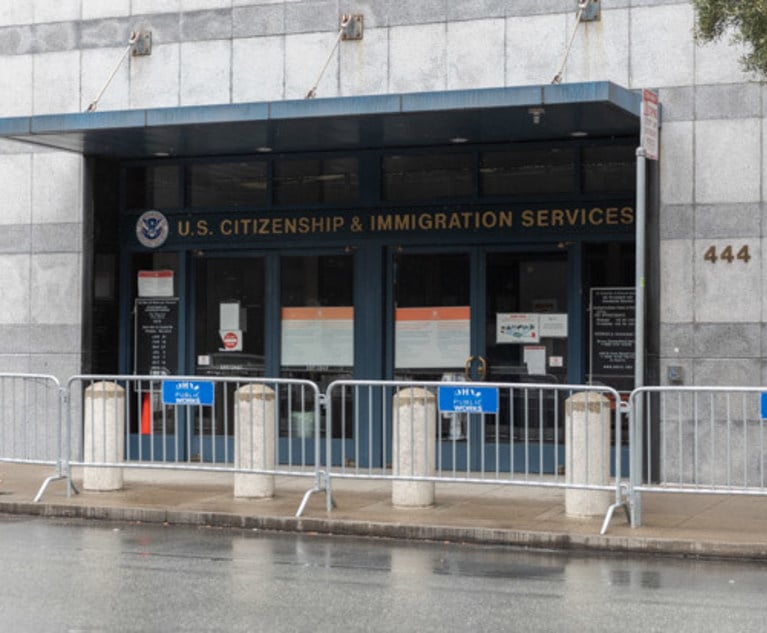 Migrants from Colombia wait to be processed after turning themselves over to authorities at the U.S. and Mexico border on May 12, 2021 in Yuma, Arizona. Credit: Ringo Chiu/Shutterstock.com
Migrants from Colombia wait to be processed after turning themselves over to authorities at the U.S. and Mexico border on May 12, 2021 in Yuma, Arizona. Credit: Ringo Chiu/Shutterstock.com US to Bolster Latin American Economies to Curb Migration
A key regional summit the U.S. will host next month comes as the number of undocumented migrants encountered at the U.S. border surged to more than 220,000 in March, the most in more than two decades.
May 10, 2022 at 10:41 AM
4 minute read
The Biden administration is working on a proposal to bolster economies in Latin America and strengthen U.S. ties ahead of a key regional summit the U.S. will host next month to help confront the challenge of fast-increasing migration.
The proposed economic framework, still in the early stages, will address issues such as so-called nearshoring and supply-chain vulnerabilities revealed by the pandemic, according to people familiar with the process, who asked not to be identified because the plans aren't public. The U.S. has started to discuss the initiative with countries in the region, and the White House is working on ideas with the U.S. Trade Representative's Office and the Commerce Department, the people said.
The framework would seek to set a new course for economic integration with the region and create an environment of stability to help attract private investment in countries where a lack of development and opportunities have spurred millions of people to migrate to the U.S.
The proposal also would counter China's growing role in the area, where the U.S.'s top geopolitical rival has increased economic ties through its Belt and Road Initiative, according to the people.
The framework would boost the focus on trade and economic cooperation at the Summit of the Americas that the U.S. is hosting for the first time in almost three decades in Los Angeles June 6-10. While summit discussion topics include the pandemic response and promoting a green and equitable recovery, the gathering is widely expected to focus on migration.
The summit comes as the number of undocumented migrants encountered at the U.S. border surged to more than 220,000 in March, the most in more than two decades, as people leave desperate situations in countries from Venezuela, Nicaragua and Cuba to the Northern Triangle nations of Honduras, El Salvador, Guatemala, as well as U.S. neighbor Mexico.
The Biden administration is preparing for a further surge as it ends a public-health policy based on COVID-19 concerns that has allowed the speedy expulsion of migrants crossing the border since March 2020. The administration plans to end that policy, known as Title 42, on May 23, just days before the summit.
The economic initiative would fit a Biden administration push globally to move beyond the traditional free-trade agreements negotiated by its predecessors.
In September, the administration launched the U.S.-EU Trade and Technology Council with the European Union, with another meeting scheduled for this month. It's also preparing to negotiate the Indo-Pacific Economic Framework, or IPEF, with countries including Japan, Singapore and New Zealand.
The Latin America framework likely will be distinct from the other initiatives based on the different challenges in the region, the people said.
The White House, Commerce Department and USTR declined to comment.
The framework would provide a partial return to the trade focus of the Summit of the Americas, which was first hosted by President Bill Clinton in Miami in 1994 and normally takes place every three to four years.
The first gathering took place a year after the U.S., Mexico and Canada had just signed the North American Free Trade Agreement. Since then, the U.S. has signed free-trade deals with Chile, Colombia, Costa Rica, the Dominican Republic, El Salvador, Guatemala, Honduras, Nicaragua, Panama and Peru.
The U.S. agreed to a NAFTA replacement agreement with Mexico and Canada under demands from President Donald Trump, which went into effect in 2020. But its pacts with other countries in Latin America are almost all more than a decade old, and the framework would build upon those deals.
The chance for the U.S. to update its trade rules with Chile and Peru was lost when Trump in 2017 withdrew the U.S. from the Trans-Pacific Partnership, or TPP, which also included several nations in Asia.
In that sense, a Latin American framework would have a similar impetus to the deal in the Indo-Pacific, which the Biden administration is using to get more involved and set standards in areas such as decarbonization and digital technologies after deciding not to join the TPP's successor agreement reached by the 11 remaining nations.
But countries in the Americas have sometimes struggled to agree on trade issues. The first Summit of the Americas in 1994 was used to launch the idea of extending NAFTA's free trade to include Central and South America. That push collapsed in 2005 over differences such as demands from leftist governments in Argentina and Brazil that the U.S. eliminate agricultural subsidies.
Eric Martin and Jenny Leonard report for Bloomberg News.
NOT FOR REPRINT
© 2025 ALM Global, LLC, All Rights Reserved. Request academic re-use from www.copyright.com. All other uses, submit a request to [email protected]. For more information visit Asset & Logo Licensing.
You Might Like
View All
Lawyers' Phones Are Ringing: What Should Employers Do If ICE Raids Their Business?
6 minute read
EB-5 Rebounds After a Rocky Year: Challenges of 2024 Lay Groundwork for a Booming 2025

'Close Our Borders?' Senate Judiciary Committee Examines Economics, Legal Predicate for Mass Deportation Proposal
3 minute read
Anticipating a New Era of 'Extreme Vetting,' Big Law Immigration Attys Prep for Demand Surge
6 minute readTrending Stories
- 1Advance Auto Parts Hires GC Who Climbed From Bottom to Top of Lowe's Legal Department
- 2Judge Rules Georgia Railroad Can Seize Land as Landowners Vow to Fight
- 3On the Move and After Hours: Einhorn Barbarito; Gibbons; Greenbaum Rowe; Pro Bono Partnership
- 4On The Move: Squire Patton Boggs, Akerman Among Four Firms Adding Atlanta Partners
- 5Is the Collateral Order Doctrine About to Have a 'Brat Summer'?
Who Got The Work
J. Brugh Lower of Gibbons has entered an appearance for industrial equipment supplier Devco Corporation in a pending trademark infringement lawsuit. The suit, accusing the defendant of selling knock-off Graco products, was filed Dec. 18 in New Jersey District Court by Rivkin Radler on behalf of Graco Inc. and Graco Minnesota. The case, assigned to U.S. District Judge Zahid N. Quraishi, is 3:24-cv-11294, Graco Inc. et al v. Devco Corporation.
Who Got The Work
Rebecca Maller-Stein and Kent A. Yalowitz of Arnold & Porter Kaye Scholer have entered their appearances for Hanaco Venture Capital and its executives, Lior Prosor and David Frankel, in a pending securities lawsuit. The action, filed on Dec. 24 in New York Southern District Court by Zell, Aron & Co. on behalf of Goldeneye Advisors, accuses the defendants of negligently and fraudulently managing the plaintiff's $1 million investment. The case, assigned to U.S. District Judge Vernon S. Broderick, is 1:24-cv-09918, Goldeneye Advisors, LLC v. Hanaco Venture Capital, Ltd. et al.
Who Got The Work
Attorneys from A&O Shearman has stepped in as defense counsel for Toronto-Dominion Bank and other defendants in a pending securities class action. The suit, filed Dec. 11 in New York Southern District Court by Bleichmar Fonti & Auld, accuses the defendants of concealing the bank's 'pervasive' deficiencies in regards to its compliance with the Bank Secrecy Act and the quality of its anti-money laundering controls. The case, assigned to U.S. District Judge Arun Subramanian, is 1:24-cv-09445, Gonzalez v. The Toronto-Dominion Bank et al.
Who Got The Work
Crown Castle International, a Pennsylvania company providing shared communications infrastructure, has turned to Luke D. Wolf of Gordon Rees Scully Mansukhani to fend off a pending breach-of-contract lawsuit. The court action, filed Nov. 25 in Michigan Eastern District Court by Hooper Hathaway PC on behalf of The Town Residences LLC, accuses Crown Castle of failing to transfer approximately $30,000 in utility payments from T-Mobile in breach of a roof-top lease and assignment agreement. The case, assigned to U.S. District Judge Susan K. Declercq, is 2:24-cv-13131, The Town Residences LLC v. T-Mobile US, Inc. et al.
Who Got The Work
Wilfred P. Coronato and Daniel M. Schwartz of McCarter & English have stepped in as defense counsel to Electrolux Home Products Inc. in a pending product liability lawsuit. The court action, filed Nov. 26 in New York Eastern District Court by Poulos Lopiccolo PC and Nagel Rice LLP on behalf of David Stern, alleges that the defendant's refrigerators’ drawers and shelving repeatedly break and fall apart within months after purchase. The case, assigned to U.S. District Judge Joan M. Azrack, is 2:24-cv-08204, Stern v. Electrolux Home Products, Inc.
Featured Firms
Law Offices of Gary Martin Hays & Associates, P.C.
(470) 294-1674
Law Offices of Mark E. Salomone
(857) 444-6468
Smith & Hassler
(713) 739-1250






